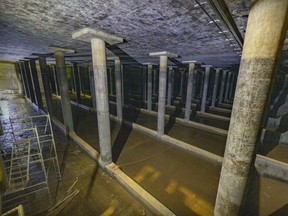The city and its residents must act now to adapt to intense rainstorms, because climate change makes these events more frequent and intense
Article content
Despite millions invested to increase sewer capacity and ongoing work to add retention basins, Montreal’s highway and sewer systems simply cannot handle the volumes of water that fell on Montreal in just a few hours on Wednesday afternoon, officials said.
Environment and Climate Change Canada said it was the wettest July 10 on record in Montreal, with some parts of central Montreal receiving up to 100 millimetres of rain in just a couple of hours. Montreal-Trudeau International Airport recorded 79 mm of rain, beating a previous record of 33 mm, and most of that rain came in a single hour.
Advertisement 2
Article content
“It was a massive amount of rain and our sewer system isn’t built to catch all that water,” Philippe Sabourin, a spokesperson for the city of Montreal said in an interview Thursday. “Most of our sewer system was built in the ’60s. We weren’t at the time concerned about climate change and there is no way the city can change its water system in months. We will need years to complete this construction work.”
As often happens during major rainstorms, Montreal’s sewer system was overwhelmed with the run-off and untreated wastewater was released into the St. Lawrence and Prairies rivers. For the next three days, the city is warning people to avoid swimming in or doing other water sports that involve direct contact with the water in these rivers.
Sabourin said the city received about 1,500 calls on its 311 line Wednesday from residents reporting flooded basements, flooded streets and clogged sewers as heavy rain resulting from the remnants of tropical storm Beryl.
The torrential downpour flooded highway underpasses and parts of the Décarie Expressway trench, leaving hundreds of commuters stuck in their cars for hours. A section of the Décarie had to be closed at 2:30 p.m. for about three hours, while Highway 40 eastbound was closed from 4 p.m. to about 10 p.m., said Louis-André Bertrand, a spokesperson for Quebec’s transport department.
Article content
Advertisement 3
Article content
“The ministry’s infrastructure — pumps and sumps installed on Highway 15 — were fully functional yesterday,” Bertrand said. “Due to the exceptional amount of precipitation received in a short time in the affected areas, the city’s storm sewer network was temporarily saturated and could not accommodate the water pumped by our drainage systems.”
At one point on Wednesday, more than 8,000 Hydro-Québec customers in the region had lost power, mostly due to problems caused by the storm. For example, the electrical room of an apartment tower in the borough of St-Laurent was flooded and so the utility had to cut power to an entire sector for several hours, affecting more than 3,000 households.
Sabourin said the city has invested in more than 20 underground retention basins, which can hold massive amounts of overflow from the sewer system during rainstorms, but still, intense storms can overwhelm the system.
The city is investing $390 million over the next 10 years to update, repair and expand its sewer system. Montreal is also planning to spend $190 million over the next decade on “green infrastructure” projects to deal with the intense rainstorms that are expected to be more common due to climate change.
Advertisement 4
Article content

The city has built seven “sponge parks”, that are built lower than street level so that water drains from the street into the park during heavy rains, or that have depressed areas designed to turn into temporary lakes or streams during rainstorms. In the last decade, the city has built about 800 curb extensions or other types of what it calls “bio-retention cells,” which have the double purpose of calming traffic and absorbing rain water in their planted areas. “Sponge streets” are roads that incorporate surface retention basins, planted areas, gravel or drainage networks to deal with run-off. Montreal’s first planned sponge street is Larivière St. near De Lorimier Ave. in the Ville-Marie borough in the spring of 2025.
But Bertrand stressed that the city cannot do all of the required work immediately, noting Montrealers are already putting up with an impressive amount of road closures as the city updates its aged infrastructure.
He said citizens can also do their part to reduce the amount of rainwater that washes into and overwhelms the sewer system during heavy rains. Ensuring that the downspouts from their roofs lead into gardens, rather than onto asphalt and into the city sewers, is one way to help. Rain barrels that catch the rain, so it can be used to irrigate gardens later, is another.
Advertisement 5
Article content
Blair Feltmate, head of the Intact Centre on Climate Adaptation at the University of Waterloo, noted that these heavy rain events are driven by climate change that has already happened and is irreversible, so cities and their citizens must adapt.
“We are not going backwards on climate change. We can slow it down but we can’t stop it,” Feltmate said. “So yes, we should be mitigating greenhouse gas emissions to slow down the rate of change, but also recognizing that we need to adapt to the extreme weather conditions that are upon us with increasing frequency; flooding, wildfires, extreme heat, etc.”
He said cities need to work on flood risk maps to figure out where the water will go during these major precipitation events, and then work on built and natural structures to mitigate the flood risk. But individual homeowners also need to take action to protect their homes, he said.
About 10 per cent of homeowners in Canada cannot get flood insurance for their homes, he said. “This is problematic because the average cost of a flooded basement is $54,000, so if you had the average flood without insurance or you have a limit of $20,000 or $30,000, which is becoming increasingly common, you are immediately on the hook” for tens of thousands to cover the costs of cleanup. “That has to be done instantly because … we are talking about sewer water in your basement and every hour it sits there, the damage goes up exponentially.”
Advertisement 6
Article content
He said homeowners should regularly check that their sump pump is functional and has battery power or a generator to ensure it works when electricity is out. They should also protect window wells with plastic and ensure the grading around their house directs water away rather than toward their home. Homeowners should also check the seal on their backwater valve twice annually to ensure sewer water can’t back up into their basement during a heavy rainstorm. “If you don’t clean it out in the spring and fall — it takes about 10 minutes with a toilet brush — it won’t seal properly and sewer water can still come up into your basement.”
Canada has a National Adaptation Strategy, which sets targets for cities to help them prepare for the more frequent and intense rainstorms that climate change is expected to bring. The strategy aims to see 50 per cent of Canadians taking concrete action to prepare for and respond to risks facing their households due to climate change, and by 2030 for 80 per cent of public and municipal organizations to have factored climate change adaptation into their decision-making processes.
Recommended from Editorial
Advertisement 7
Article content
Article content










